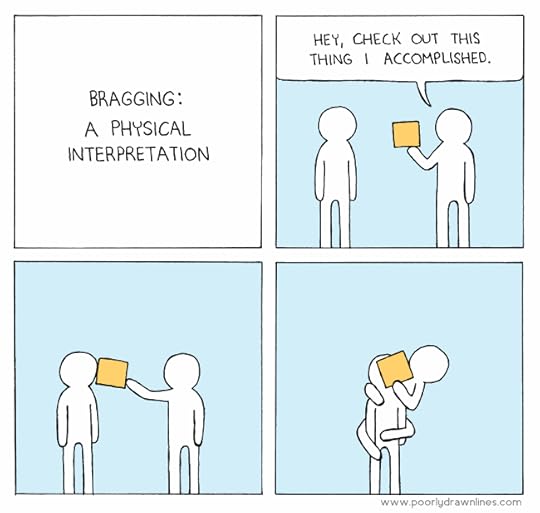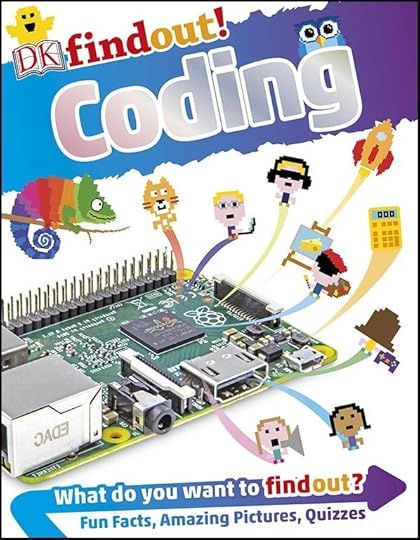Jeff Atwood's Blog, page 2
October 22, 2018
What does Stack Overflow want to be when it grows up?
I sometimes get asked by regular people in the actual real world what it is that I do for a living, and here's my 15 second answer:
We built a sort of Wikipedia website for programmers to post questions and answers. It's called Stack Overflow.
As of last month, it's been 10 years since Joel Spolsky and I started Stack Overflow. I currently do other stuff now, and I have since 2012, but if I will be known for anything when I'm dead, clearly it is going to be good old Stack Overflow.
Here's where I'd normally segue into a bunch of rah-rah stuff about how great Stack Overflow is, and thus how implicitly great I am by association for being a founder, and all.
I do not care about any of that.
What I do care about, though, is whether Stack Overflow is useful to working programmers. Let's check in with one of my idols, John Carmack. How useful is Stack Overflow, from the perspective of what I consider to be one of the greatest living programmers?
@StackExchange @codinghorror SO has probably added billions of dollars of value to the world in increased programmer productivity.
— John Carmack (@ID_AA_Carmack) September 17, 2013
I won't lie, September 17th, 2013 was a pretty good day. I literally got chills when I read that, and not just because I always read the word "billions" in Carl Sagan's voice. It was also pleasantly the opposite of pretty much every other day I'm on Twitter, scrolling through an oppressive, endless litany of shared human suffering and people screaming at each other. Which reminds me, I should check my Twitter and see who else is wrong on the Internet today.
I am honored and humbled by the public utility that Stack Overflow has unlocked for a whole generation of programmers. But I didn't do that.
You did, when you contributed a well researched question to Stack Overflow.
You did, when you contributed a succinct and clear answer to Stack Overflow.
You did, when you edited a question or answer on Stack Overflow to make it better.
All those "fun size" units of Q&A collectively contributed by working programmers from all around the world ended up building a Creative Commons resource that truly rivals Wikipedia within our field. That's ... incredible, actually.
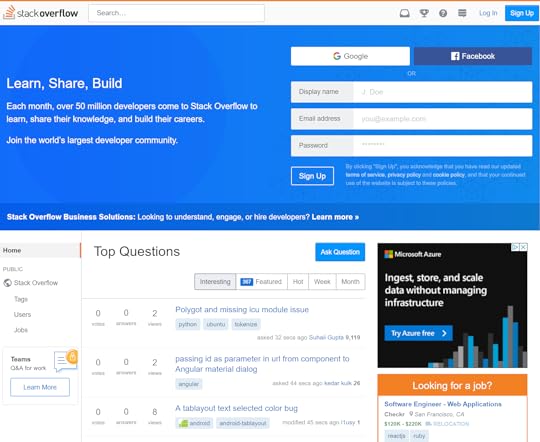
But success stories are boring. The world is filled with people that basically got lucky, and subsequently can't stop telling people how it was all of their hard work and moxie that made it happen. I find failure much more instructive, and when building a business and planning for the future, I take on the role of Abyss Domain Expert™ and begin a staring contest. It's just a little something I like to do, you know ... for me.
Thus, what I'd like to do right now is peer into that glorious abyss for a bit and introspect about the challenges I see facing Stack Overflow for the next 10 years. Before I begin, I do want to be absolutely crystal clear about a few things:
I have not worked at Stack Overflow in any capacity whatsoever since February 2012 and I've had zero day to day operational input since that date, more or less by choice. Do I have opinions about how things should be done? Uh, have you met me? Do I email people every now and then about said opinions? I might, but I honestly do try to keep it to an absolute minimum, and I think my email archive track record here is reasonable.
The people working at Stack are amazing and most of them (including much of the Stack Overflow community, while I'm at it) could articulate the mission better — and perhaps a tad less crankily — than I could by the time I left. Would I trust them with my life? No. But I'd trust them with Joel's life!
The whole point of the Stack Overflow exercise is that it's not beholden to me, or Joel, or any other Great Person. Stack Overflow works because it empowers regular everyday programmers all over the world, just like you, just like me. I guess in my mind it's akin to being a parent. The goal is for your children to eventually grow up to be sane, practicing adults who don't need (or, really, want) you to hang around any more.
Understand that you're reading the weak opinions strongly held the strong opinions weakly held of a co-founder who spent prodigious amounts of time working with the community in the first four years of Stack Overflow's life to shape the rules and norms of the site to fit their needs. These are merely my opinions. I like to think they are informed opinions, but that doesn't necessarily mean I can predict the future, or that I am even qualified to try. I've never let being "qualified" stop me from doing anything, and I ain't about to start tonight.
Stack Overflow is a wiki first
Stack Overflow ultimately has much more in common with Wikipedia than a discussion forum. By this I mean questions and answers on Stack Overflow are not primarily judged by their usefulness to a specific individual, but by how many other programmers that question or answer can potentially help over time. I tried as hard as I could to emphasize this relationship from launch day in 2008. Note who has top billing in this venn diagram.
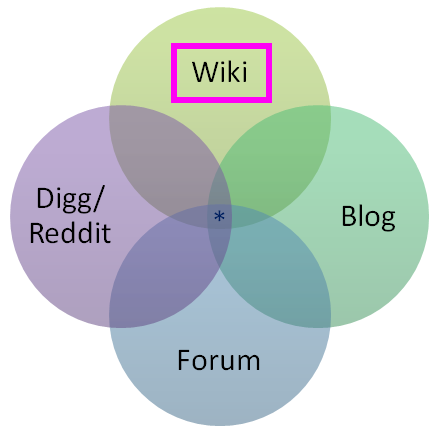
Stack Overflow later added a super neat feature to highlight this core value in user profiles, where it shows how many other people you have potentially helped with your contributed questions and answers so far.
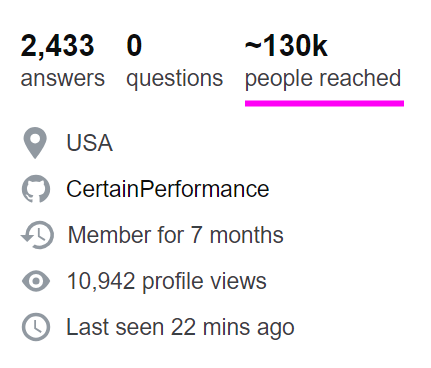
The most common complaints I see about Stack Overflow are usually the result of this fundamental misunderstanding about who the questions and answers on the site are ultimately for, and why there's so much strictness involved in the whole process.
I wish more people understood that the goal of Stack Overflow is not "answer my question" but "let's collaboratively build an artifact that will benefit future coders". Perhaps SO could be doing more to educate people about this.
— Jeff Atwood (@codinghorror) April 30, 2018
I'm continually amazed at the number of people, even on Hacker News today, who don't realize that every single question and answer is editable on Stack Overflow, even as a completely anonymous user who isn't logged in. Which makes sense, right, because Stack Overflow is a wiki, and that's how wikis work. Anyone can edit them. Go ahead, try it right now if you don't believe me — press the "improve this answer" or "improve this question" button on anything that can be improved, and make it so.

The responsibility for this misunderstanding is all on Stack Overflow (and by that also mean myself, at least up until 2012). I guess the logic is that "every programmer has surely seen, used, and understands Stack Overflow by now, 10 years in" but ... I think that's a risky assumption. New programmers are minted every second of every day. Complicating matters further, there are three tiers of usage at Stack Overflow, from biggest to smallest, in inverted pyramid style:
I passively search for programming answers.
Passively searching and reading highly ranked Stack Overflow answers as they appear in web search results is arguably the primary goal of Stack Overflow. If Stack Overflow is working like it's supposed to, 98% of programmers should get all the answers they need from reading search result pages and wouldn't need to ask or answer a single question in their entire careers. This is a good thing! Great, even!
I participate on Stack Overflow when I get stuck on a really hairy problem and searching isn't helping.
Participating only at those times when you are extra stuck is completely valid. However, I feel this level is where most people tend to run into difficulty on Stack Overflow, because it involves someone who may not be new to Stack Overflow per se, but is new to asking questions, and also at the precise time of stress and tension for them where they must get an answer due to a problem they're facing … and they don't have the time or inclination to deal with Stack Overflow's strict wiki type requirements for research effort, formatting, showing previous work, and referencing what they found in prior searches.
I participate on Stack Overflow for professional development.
At this level you're talking about experienced Stack Overflow users who have contributed many answers and thus have a pretty good idea of what makes a great question, the kind they'd want to answer themselves. As a result, they don't tend to ask many questions because they self-medicate through exhaustive searching and research, but when they do ask one, their questions are exemplary.
(There's technically a fourth tier here, for people who want to selflessly contribute creative commons questions and answers to move the entire field of software development forward for the next generation of software developers. But who has time for saints
September 21, 2018
There is no longer any such thing as Computer Security
Remember "cybersecurity"?

Mysterious hooded computer guys doing mysterious hooded computer guy .. things! Who knows what kind of naughty digital mischief they might be up to?
Unfortunately, we now live in a world where this kind of digital mischief is literally rewriting the world's history. For proof of that, you need look no further than this single email that was sent March 19th, 2016.
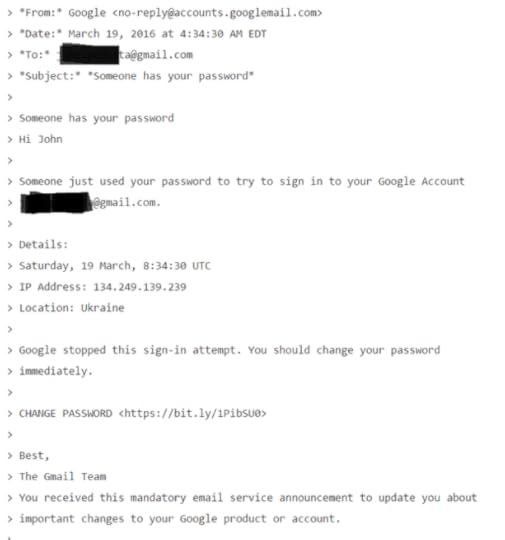
If you don't recognize what this is, it is a phishing email.
This is by now a very, very famous phishing email, arguably the most famous of all time. But let's consider how this email even got sent to its target in the first place:
An attacker slurped up lists of any public emails of 2008 political campaign staffers.
One 2008 staffer was also hired for the 2016 political campaign
That particular staffer had non-public campaign emails in their address book, and one of them was a powerful key campaign member with an extensive email history.
On successful phish leads to an even wider address book attack net down the line. Once they gain access to a person's inbox, they use it to prepare to their next attack. They'll harvest existing email addresses, subject lines, content, and attachments to construct plausible looking boobytrapped emails and mail them to all of their contacts. How sophisticated and targeted to a particular person this effort is determines whether it's so-called "spear" phishing or not.
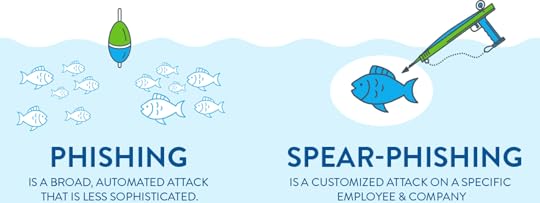
In this case is it was not at all targeted. This is a remarkably unsophisticated, absolutely generic routine phishing attack. There is zero focused attack effort on display here. But note the target did not immediately click the link in the email!
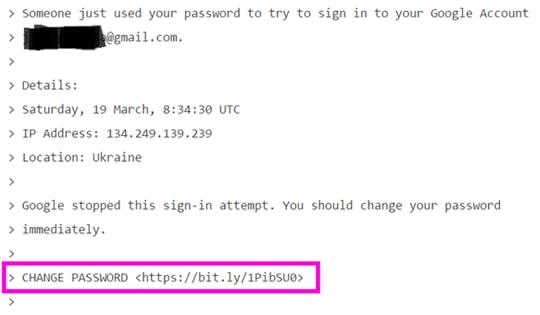
Instead, he did exactly what you'd want a person to do in this scenario: he emailed IT support and asked if this email was valid. But IT made a fatal mistake in their response.
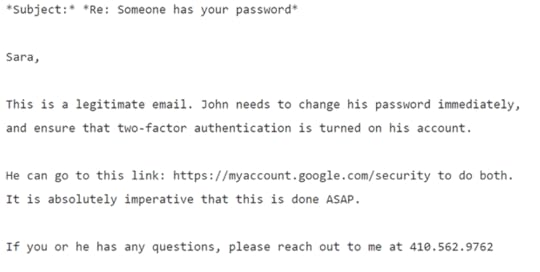
Do you see it? Here's the kicker:
Mr. Delavan, in an interview, said that his bad advice was a result of a typo: He knew this was a phishing attack, as the campaign was getting dozens of them. He said he had meant to type that it was an “illegitimate” email, an error that he said has plagued him ever since.
One word. He got one word wrong. But what a word to get wrong, and in the first sentence! The email did provide the proper Google address to reset your password. But the lede was already buried since the first sentence said "legitimate"; the phishing link in that email was then clicked. And the rest is literally history.
What's even funnier (well, in the way of gallows humor, I guess) is that public stats were left enabled for that bit.ly tracking link, so you can see exactly what crazy domain that "Google login page" resolved to, and that it was clicked exactly twice, on the same day it was mailed.
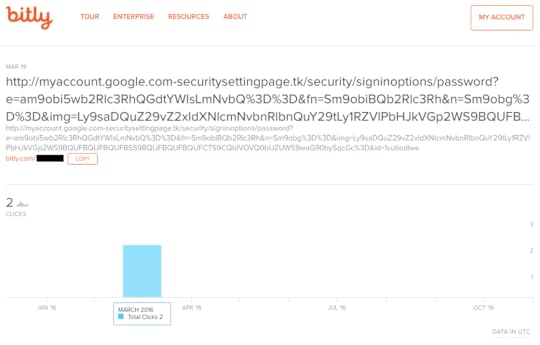
As I said, these were not exactly sophisticated attackers. So yeah, in theory an attentive user could pay attention to the browser's address bar and notice that after clicking the link, they arrived at
http://myaccount.google.com-securitys...
instead of
https://myaccount.google.com/security
Note that the phishing URL is carefully constructed so the most "correct" part is at the front, and weirdness is sandwiched in the middle. Unless you're paying very close attention and your address bar is long enough to expose the full URL, it's … tricky. See this 10 second video for a dramatic example.
Quick phishing demo. Would you fall for something like this? pic.twitter.com/phONMKHBle
— Mustafa Al-Bassam (@musalbas) September 9, 2018
(And if you think that one's good, check out this one. Don't forget all the unicode look-alike trickery you can pull, too.)
I originally wrote this post as a presentation for the Berkeley Computer Science Club back in March, and at that time I gathered a list of public phishing pages I found on the web.
nightlifesofl.com
ehizaza-limited.com
tcgoogle.com
appsgoogie.com
security-facabook.com
Of those five examples from 6 months ago, one is completely gone, one loads just fine, and three present an appropriately scary red interstitial warning page that strongly advises you not to visit the page you're trying to visit, courtesy of Google's safe browsing API. But of course this kind of shared blacklist domain name protection will be completely useless on any fresh phishing site. (Don't even get me started on how blacklists have never really worked anyway.)
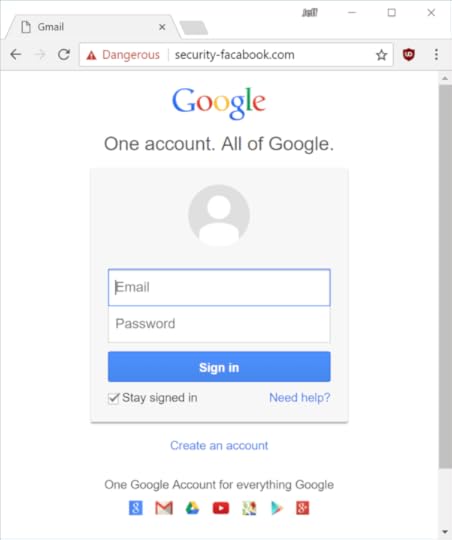
It doesn't exactly require a PhD degree in computer science to phish someone:
Buy a crazy long, realistic looking domain name.
Point it to a cloud server somewhere.
Get a free HTTPS certificate courtesy of our friends at Let's Encrypt.
Build a realistic copy of a login page that silently transmits everything you type in those login fields to you – perhaps even in real time, as the target types.
Harvest email addresses and mass mail a plausible looking phishing email with your URL.
I want to emphasize that although clearly mistakes were made in this specific situation, none of the people involved here were amateurs. They had training and experience. They were working with IT and security professionals. Furthermore, they knew digital attacks were incoming.
The … campaign was no easy target; several former employees said the organization put particular stress on digital safety.
Work emails were protected by two-factor authentication, a technique that uses a second passcode to keep accounts secure. Most messages were deleted after 30 days and staff went through phishing drills. Security awareness even followed the campaigners into the bathroom, where someone put a picture of a toothbrush under the words: “You shouldn’t share your passwords either.”
The campaign itself used two factor auth extensively, which is why personal gmail accounts were targeted, because they were less protected.
The key takeaway here is that it's basically impossible, statistically speaking, to prevent your organization from being phished.
Or is it?
Nobody is doing better work in this space right now than Maciej Ceglowski and Tech Solidarity. Their list of basic security precautions for non-profits and journalists is pure gold and has been vetted by many industry professionals with security credentials that are actually impressive, unlike mine. Everyone should read this list very closely, point by point.
Everyone?
Computers, courtesy of smartphones, are now such a pervasive part of average life for average people that there is no longer any such thing as "computer security". There is only security. In other words, these are normal security practices everyone should be familiar with. Not just computer geeks. Not just political activists and politicians. Not just journalists and nonprofits.
Everyone.
It is a fair bit of reading, so because I know you are just as lazy as I am, and I am epically lazy, let me summarize what I view as the three important takeaways from the hard work Tech Solidarity put into these resources. These three short sentences are the 60 second summary of what you want to do, and what you want to share with others so they do, too.
1) Enable Two Factor authentication through an app, and not SMS, everywhere you can.
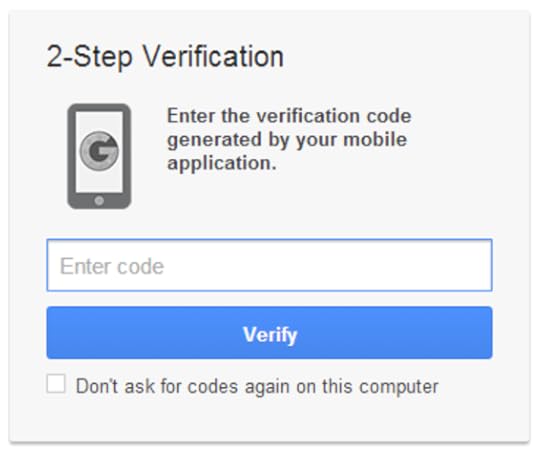
Logging in with only a password, now matter how long and unique you attempt to make that password, will never be enough. A password is what you know; you need to add the second factor of something you have (or something you are) to achieve significant additional security. SMS can famously be intercepted, social engineered, or sim-jacked all too easily. If it's SMS, it's not secure, period. So install an authenticator app, and use it, at least for your most important credentials such as your email account and your bank.
Have I mentioned that Discourse added two factor authentication support in version 2.0, and our just released 2.1 adds printed backup codes, too? There are two paths forward: you can talk about the solution, or you can build the solution. I'm trying to do both to the best of my ability. Look for the 2FA auth option in your user preferences on your favorite Discourse instance. It's there for you.
(This is also a company policy at Discourse; if you work here, you 2FA everything all the time. No other login option exists.)
2) Make all your passwords 11 characters or more.
It's a long story, but anything under 11 characters is basically the same as having no password at all these days. I personally recommend at least 14 characters, maybe even 16. But this won't be a problem for you, because...
3) Use a password manager.
If you use a password manager, you can simultaneously avoid the pernicious danger of password re-use and the difficulty of coming up with unique and random passwords all the time. It is my hope in the long run that cloud based password management gets deeply built into Android, iOS, OSX, and Windows so that people don't need to run a weird melange of third party apps to achieve this essential task. Password management is foundational and should not be the province of third parties on principle, because you never outsource a core competency.
Bonus rule! For the particularly at-risk, get and use a U2F key.
In the long term, two factor through an app isn't quite secure enough due to the very real (and growing) specter of real-time phishing. Authentication apps offer timed keys that expire after a minute or two, but if the attacker can get you to type an authentication key and relay it to the target site fast enough, they can still log in as you. If you need ultimate protection, look into U2F keys.

I believe U2F support is still too immature at the moment, particularly on mobile, for this to be practical for the average person right now. But if you do happen to fall into those groups that will be under attack, you absolutely want to set up U2F keys where you can today. They're cheap, and the good news is that they literally make phishing impossible at last. Given that Google had 100% company wide success against phishing with U2F, we know this works.
In today's world, computers are now so omnipresent that there is no longer any such thing as cybersecurity, online security, or computer security – there's only security. You either have it, or you don't. If you follow and share these three rules, hopefully you too can have a modicum of security today.
December 30, 2017
To Serve Man, with Software
I didn't choose to be a programmer. Somehow, it seemed, the computers chose me. For a long time, that was fine, that was enough; that was all I needed. But along the way I never felt that being a programmer was this unambiguously great-for-everyone career field with zero downsides. There are absolutely occupational hazards of being a programmer, and one of my favorite programming quotes is an allusion to one of them:
It should be noted that no ethically-trained software engineer would ever consent to write a DestroyBaghdad procedure. Basic professional ethics would instead require him to write a DestroyCity procedure, to which Baghdad could be given as a parameter.
Which reminds me of another joke that people were telling in 2015:
Donald Trump is basically a comment section running for president
Which is troubling because technically, technically, I run a company that builds comment sections.
Here at the tail end of 2017, from where I sit neither of these jokes seem particularly funny to me any more. Perhaps I have lost the capacity to feel joy as a human being? Haha just kidding! ... kinda.
Remember in 2011 when Marc Andreeseen said that "Software is eating the world?"

That used to sound all hip and cool and inspirational, like "Wow! We software developers really are making a difference in the world!" and now for the life of me I can't read it as anything other than an ominous warning that we just weren't smart enough to translate properly at the time. But maybe now we are.
I've said many, many times that the key to becoming an experienced software developer is to understand that you are, at all times, your own worst enemy. I don't mean this in a negative way – you have to constantly plan for and design around your inevitable human mistakes and fallibility. It's fundamental to good software engineering because, well, we're all human. The good-slash-bad news is that you're only accidentally out to get yourself. But what happens when we're infinitely connected and software is suddenly everywhere, in everyone's pockets every moment of the day, starting to approximate a natural extension of our bodies? All of a sudden those little collective social software accidents become considerably more dangerous:
The issue is bigger than any single scandal, I told him. As headlines have exposed the troubling inner workings of company after company, startup culture no longer feels like fodder for gentle parodies about ping pong and hoodies. It feels ugly and rotten. Facebook, the greatest startup success story of this era, isn’t a merry band of hackers building cutesy tools that allow you to digitally Poke your friends. It’s a powerful and potentially sinister collector of personal data, a propaganda partner to government censors, and an enabler of discriminatory advertising.
I'm reminded of a particular Mitchell and Webb skit: "Are we the baddies?"
On the topic of unanticipated downsides to technology, there is no show more essential than Black Mirror. If you haven't watched Black Mirror yet, do not pass go, do not collect $200, go immediately to Netflix and watch it. Go on! Go ahead!
⚠ Fair warning: please DO NOT start with season 1 episode 1 of Black Mirror! Start with season 3, and go forward. If you like those, dip into season 2 and the just-released season 4, then the rest. But humor me and please at least watch the first episode of season 3.
The technology described in Black Mirror can be fanciful at times, but several episodes portray disturbingly plausible scenarios with today's science and tech, much less what we'll have 20 to 50 years from now. These are very real cautionary tales, and some of this stuff is well on its way toward being realized.
Programmers don't think of themselves as people with the power to change the world. Most programmers I know, including myself, grew up as nerds, geeks, social outcasts. Did I ever tell you about the time I wrote a self-destructing Apple // boot disk program to let a girl in middle school know that I liked her? I was (and still am) a terrible programmer, but oh man did I ever test the heck out of that code before copying on to her school floppy disc. But I digress. What do you do when you wake up one day and software has kind of eaten the world, and it is no longer clear if software is in fact an unambiguously good thing, like we thought, like everyone told us … like we wanted it to be?
Months ago I submitted a brief interview for a children's book about coding.
I recently recieved a complimentary copy of the book in the mail. I paged to my short interview, alongside the very cool Kiki Prottsman. I had no real recollection of the interview questions after the months of lead time it takes to print a physical book, but reading the printed page, I suddenly hit myself over the head with the very answer I had been searching my soul for these past 6 months:
In attempting to simplify my answers for an audience of kids, I had concisely articulated the one thing that keeps me coming back to software: to serve man. Not on a platter, for bullshit monetization – but software that helps people be the best version of themselves.
And you know why I do it? I need that help, too. I get tired, angry, upset, emotional, cranky, irritable, frustrated and I need to be reminded from time to time to choose to be the better version of myself. I don't always succeed. But I want to. And I believe everyone else – for some reasonable statistical value of everyone else – fundamentally does, too.
That was the not-so-secret design philosophy behind Stack Overflow, that by helping others become better programmers, you too would become a better programmer. It's unavoidable. And, even better, if we leave enough helpful breadcrumbs behind for those that follow us, we collectively advance the whole of programming for everyone.
I apologize for not blogging much in 2017. I've certainly been busy with Discourse which is actually going great; we grew to 21 people and gave $55,000 back this year to the open source ecosystem we build on. But that's no excuse. The truth is that it's been hard to write because this has been a deeply troubling year in so many dimensions — for men, for tech, for American democracy. I'm ashamed of much that happened, and I think one of the first and most important steps we can take is to embrace explicit codes of conduct throughout our industry. I also continue to believe, if we start to think more holistically about what our software can do to serve all people, not just ourselves personally (or, even worse, the company we work for) — that software can and should be part of the solution.
I tried to amplify on these thoughts in recent podcasts:

Community Engineering Report with Kim Crayton

Developer on Fire with Dave Rael

Dorm Room Tycoon with William Channer
Software is easy to change, but people ... aren't. So in the new year, as software developers, let's make a resolution to focus on the part we can change, and keep asking ourselves one very important question: how can our software help people become the best version of themselves?
November 5, 2017
The Existential Terror of Battle Royale
It's been a while since I wrote a blog post, I guess in general, but also a blog post about video games. Video games are probably the single thing most attributable to my career as a programmer, and everything else I've done professionally after that. I still feel video games are one of the best ways to learn and teach programming, if properly scoped, and furthermore I take many cues from video games in building software.
I would characterize my state of mind for the last six to eight months as … poor. Not only because of current events in the United States, though the neverending barrage of bad news weighs heavily on me, and I continue to be profoundly disturbed by the erosion of core values that I thought most of us stood for as Americans. Didn't we used to look out for each other, care about each other, and fight to protect those that can't protect themselves?
In times like these, I sometimes turn to video games for escapist entertainment. One game in particular caught my attention because of its unprecedented rise in player count over the last year.
That game is Player Unknown's Battlegrounds. I was increasingly curious why it was so popular, and kept getting more popular every month. Calling it a mere phenomenon seems like underselling it; something truly unprecedented is happening here. I finally broke down and bought a copy for $30 in September.

After a few hours in, I had major flashbacks to the first time I played Counter-Strike in 1998. I realized that we are witnessing the birth of an entirely new genre of game: the Battle Royale. I absolutely believe that huge numbers of people will still be playing some form of this game 20 years from now, too.
I've seen the Japanese movie, and it's true that there were a few Battle Royale games before PUBG, but this is clearly the defining moment and game for the genre, the one that sets a precedent for everyone else to follow.
It's hard to explain why Battlegrounds is so compelling, but let's start with the loneliness.
Although you can play in squads (and I recommend it), the purest original form of the game is 100 players, last man standing. You begin with nothing but the clothes on your back, in a cargo aircraft, flying over an unknown island in a random trajectory.

It's up to you to decide when to drop, and where to land on this huge island, full of incredibly detailed cities, buildings and houses – but strangely devoid of all life. What happened to everyone? Where did they go? The sense of apocalypse is overwhelming. It's you versus the world, but where did the world go?

You'll wander this vast deserted island, scavenging for weapons and armor in near complete silence. You'll hear nothing but the wind blowing and the occasional buzzing of flies. But then, suddenly the jarring pak-pak-pak of gunfire off in the distance, reminding you that other people are here. And they aren't your friends.

the dread of never knowing when another of the 100 players on this enormous island is going to suddenly appear around a corner or over a hill is intense. You'll find yourself wearing headphones, cranking the volume, constantly on edge listening for the implied threat of footfalls. Wait, did I hear someone just now, or was that me? You clench, and wait. I've had so many visceral panic moments playing this game, to the point that I had to stop playing just to calm down.

PUBG is, in its way, the scariest zombie movie I've ever seen, though it lacks a single zombie. It dispenses with the pretense of a story, so you can realize much sooner that the zombies, as terrible as they may be, are nowhere as dangerous to you as your fellow man.
Meanwile, that huge cargo airplane still roars overhead every so often, impassive, indifferent, occasionally dropping supply crates with high powered items to fight over. Airstrikes randomly target areas circled in red on the map, masking footfalls, and forcing movement while raining arbitrary death and terror.

Although the island is huge and you can land anywhere, after a few minutes a random circle is overlaid on the map, and a slowly moving wall of deadly energy starts closing in on that circle. Stay outside that circle at your peril; if you find yourself far on the opposite side of the map from a circle, you better start hunting for a vehicle or boat (they're present, but rare) quickly. These terrordome areas are always shrinking, always impending, in an ever narrowing cone, forcing the remaining survivors closer and closer together. The circles get tighter and deadlier and quicker as the game progresses, ratcheting up the tension and conflict.
Eventually the circle becomes so small that it's impossible for the handful of remaining survivors to avoid contact, and one person, one out of the hundred that originally dropped out of the cargo plane, emerges as the winner. I've never won solo, but I have won squad, and even finishing first out of 25 squads is an unreal, euphoric experience. The odds are so incredibly against you from the outset, plus you quickly discover that 85% of the game is straight up chance: someone happens to roll up behind you, a sniper gets the drop on you, or you get caught in the open with few options. Wrong place, wrong time, game over. Sucks to be you.

You definitely learn to be careful, but there's only so careful you can be. Death comes quickly, without warning, and often at random. What else can you expect from a game mode where there are 100 players but only 1 eventual winner?
There haven't been many Battle Royale games, so this game mode is a relatively new phenomenon. If you'd like to give it a try for free, I highly recommend Fortnite's Battle Royale mode which is 100% free, a near-clone of PUBG, and quite good in its own right. They added their Battle Royale mode well after the fact; the core single player "save the world" gameplay of building stuff and fighting zombie hordes is quite fun too, though a bit shallow. It also has what is, in my opinion, some of the most outstanding visual style I've ever seen in a game – a cool, hyperbolic cartoon mix of Chuck Jones, Sam & Max, and Cloudy with a Chance of Meatballs. It's also delightfully diverse in its character models.
(The only things you'll give up over PUBG are the realistic art style, vehicles, and going prone. But the superb structure building system in Fortnite almost makes up for that. If nothing else it is a demonstration of how incredibly compelling the Battle Royale game mode is, because that part of the game is wildly successful in a a way that the core game, uh, wasn't. Also it's free!)
I didn't intend for this to happen, but to me, the Battle Royale game mode perfectly captures the zeitgeist of the current moment, and matches my current state of mind to a disturbing degree. It's an absolutely terrifying experience of every human for themselves, winner takes all, with impossible odds. There are moments it can be thrilling, even inspiring, but mostly it's harsh and unforgiving. To succeed you need to be exceedingly cautious, highly skilled, and just plain lucky. Roll the dice again, but know that everyone will run towards the sound of gunfire in hopes of picking off survivors and looting their corpses. Including you.
Battle Royale is not the game mode we wanted, it's not the game mode we needed, it's the game mode we all deserve. And the best part is, when we're done playing, we can turn it off.
June 2, 2017
Hacker, Hack Thyself
We've read so many sad stories about communities that were fatally compromised or destroyed due to security exploits. We took that lesson to heart when we founded the Discourse project; we endeavor to build open source software that is secure and safe for communities by default, even if there are thousands, or millions, of them out there.
However, we also value portability, the ability to get your data into and out of Discourse at will. This is why Discourse, unlike other forum software, defaults to a Creative Commons license. As a basic user on any Discourse you can easily export and download all your posts right from your user page.

As a site owner, you can easily back up and restore your entire site database from the admin panel, right in your web browser. Automated weekly backups are set up for you out of the box, too. I'm not the world's foremost expert on backups for nothing, man!
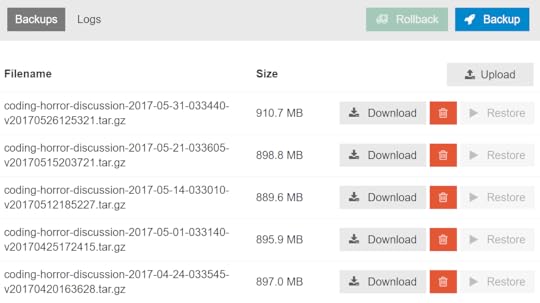
Over the years, we've learned that balancing security and data portability can be tricky. You bet your sweet ASCII a full database download is what hackers start working toward the minute they gain any kind of foothold in your system. It's the ultimate prize.
To mitigate this threat, we've slowly tightened restrictions around Discourse backups in various ways:
Administrators have a minimum password length of 15 characters.
Both backup creation and backup download administrator actions are formally logged.
Backup download tokens are single use and emailed to the address of the administrator, to confirm that user has full control over the email address.
The name of the security game is defense in depth, so all these hardening steps help … but we still need to assume that Internet Bad Guys will somehow get a copy of your database. And then what? Well, what's in the database?
Identity cookies
Cookies are, of course, how the browser can tell who you are. Cookies are usually stored as hashes, rather than the actual cookie value, so having the hash doesn't let you impersonate the target user. Furthermore, most modern web frameworks rapidly cycle cookies, so they are only valid for a brief 10 to 15 minute window anyway.
Email addresses
Although users have reason to be concerned about their emails being exposed, very few people treat their email address as anything particularly precious these days.
All posts and topic content
Let's assume for the sake of argument that this is a fully public site and nobody was posting anything particularly sensitive there. So we're not worried, at least for now, about trade secrets or other privileged information being revealed, since they were all public posts anyway. If we were, that's a whole other blog post I can write at a later date.
Password hashes
What's left is the password hashes. And that's … a serious problem indeed.
Now that the attacker has your database, they can crack your password hashes with large scale offline attacks, using the full resources of any cloud they can afford. And once they've cracked a particular password hash, they can log in as that user … forever. Or at least until that user changes their password.
⚠️ That's why, if you know (or even suspect!) your database was exposed, the very first thing you should do is reset everyone's password.
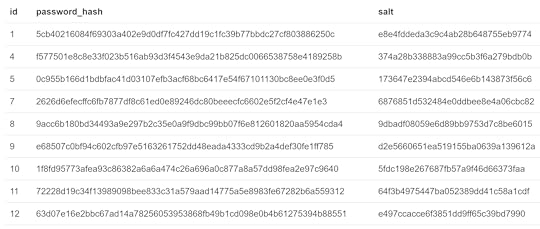
But what if you don't know? Should you preemptively reset everyone's password every 30 days, like the world's worst bigco IT departments? That's downright user hostile, and leads to serious pathologies of its own. But the reality is that you probably won't know when your database has been exposed, at least not until it's too late to do anything about it. So it's crucial to slow the attackers down, to give yourself time to deal with it and respond.
Thus, the only real protection you can offer your users is just how resistant to attack your stored password hashes are. There are two factors that go into password hash strength:
The hashing algorithm. As slow as possible, and ideally designed to be especially slow on GPUs for reasons that will become painfully obvious about 5 paragraphs from now.
The work factor or number of iterations. Set this as high as possible, without opening yourself up to a possible denial of service attack.
I've seen guidance that said you should set the overall work factor high enough that hashing a password takes at least 8ms on the target platform. It turns out Sam Saffron, one of my Discourse co-founders, made a good call back in 2013 when he selected the NIST recommendation of PBKDF2-HMAC-SHA256 and 64k iterations. We measured, and that indeed takes roughly 8ms using our existing Ruby login code on our current (fairly high end, Skylake 4.0 Ghz) servers.
But that was 4 years ago. Exactly how secure are our password hashes in the database today? Or 4 years from now, or 10 years from now? We're building open source software for the long haul, and we need to be sure we are making reasonable decisions that protect everyone. So in the spirit of designing for evil, it's time to put on our Darth Helmet and play the bad guy – let's crack our own hashes!

We're gonna use the biggest, baddest single GPU out there at the moment, the 1080 GTX Ti. As a point of reference, for PBKDF2-HMAC-SHA256 the 1080 achieves 1180 kH/s, whereas the 1080 Ti achieves 1640 kH/s. In a single video card generation the attack hash rate has increased nearly 40 percent. Ponder that.
First, a tiny hello world test to see if things are working. I downloaded hashcat. I logged into our demo at try.discourse.org and created a new account with the password 0234567890; I checked the database, and this generated the following values in the hash and salt database columns for that new user:
hash
93LlpbKZKficWfV9jjQNOSp39MT0pDPtYx7/gBLl5jw=
salt
ZWVhZWQ4YjZmODU4Mzc0M2E2ZDRlNjBkNjY3YzE2ODA=
Hashcat requires the following input file format: one line per hash, with the hash type, number of iterations, salt and hash (base64 encoded) separated by colons:
type iter salt hash
sha256:64000:ZWVhZWQ4YjZmODU4Mzc0M2E2ZDRlNjBkNjY3YzE2ODA=:93LlpbKZKficWfV9jjQNOSp39MT0pDPtYx7/gBLl5jw=
Let's hashcat it up and see if it works:
./h64 -a 3 -m 10900 .\one-hash.txt 0234567?d?d?d
Note that this is an intentionally tiny amount of work, it's only guessing three digits. And sure enough, we cracked it fast! See the password there on the end? We got it.
sha256:64000:ZWVhZWQ4YjZmODU4Mzc0M2E2ZDRlNjBkNjY3YzE2ODA=:93LlpbKZKficWfV9jjQNOSp39MT0pDPtYx7/gBLl5jw=:0234567890
Now that we know it works, let's get down to business. But we'll start easy. How long does it take to brute force attack the easiest possible Discourse password, 8 numbers – that's "only" 810 combinations, a little over one billion.
Hash.Type........: PBKDF2-HMAC-SHA256
Time.Estimated...: Fri Jun 02 00:15:37 2017 (1 hour, 0 mins)
Guess.Mask.......: ?d?d?d?d?d?d?d?d [8]
Even with a top of the line GPU that's … OK, I guess. Remember this is just one hash we're testing against, so you'd need one hour per row (user) in the table. And I have more bad news for you: Discourse hasn't allowed 8 character passwords for quite some time now. How long does it take if we try longer numeric passwords?
?d?d?d?d?d?d?d?d?d [9]
Fri Jun 02 10:34:42 2017 (11 hours, 18 mins)
?d?d?d?d?d?d?d?d?d?d [10]
Tue Jun 06 17:25:19 2017 (4 days, 18 hours)
?d?d?d?d?d?d?d?d?d?d?d [11]
Mon Jul 17 23:26:06 2017 (46 days, 0 hours)
?d?d?d?d?d?d?d?d?d?d?d?d [12]
Tue Jul 31 23:58:30 2018 (1 year, 60 days)
But all digit passwords are easy mode, for babies! How about some real passwords that use at least lowercase letters, or lowercase + uppercase + digits?
Guess.Mask.......: ?l?l?l?l?l?l?l?l [8]
Time.Estimated...: Mon Sep 04 10:06:00 2017 (94 days, 10 hours)
Guess.Mask.......: ?1?1?1?1?1?1?1?1 [8] (-1 = ?l?u?d)
Time.Estimated...: Sun Aug 02 09:29:48 2020 (3 years, 61 days)
A brute force try-every-single-letter-and-number attack is not looking so hot for us at this point, even with a high end GPU. But what if we divided the number by eight … by putting eight video cards in a single machine? That's well within the reach of a small business budget or a wealthy individual. But dividing 38 months by 8 isn't such a dramatic reduction in the time to attack. Instead, let's talk about nation state attacks where they have the budget to throw thousands of these GPUs at the problem (1.1 days), maybe even tens of thousands (2.7 hours), then … yes. Even allowing for 10 character password minimums, you are in serious trouble at that point.

If we want Discourse to be nation state attack resistant, clearly we'll need to do better. Hashcat has a handy benchmark mode, and here's a sorted list of the strongest (slowest) hashes that Hashcat knows about benchmarked on a rig with 8 Nvidia GTX 1080 GPUs. Of the things I recognize on that list, bcrypt, scrypt and PBKDF2-HMAC-SHA512 stand out.
My quick hashcat results gave me some confidence that we weren't doing anything terribly wrong with the Discourse password hashes stored in the database. But I wanted to be completely sure, so I hired someone with a background in security and penetration testing to, under a signed NDA, try cracking the password hashes of two live and very popular Discourse sites we currently host.
I was provided two sets of password hashes from two different Discourse communities, containing 5,909 and 6,088 hashes respectively. Both used the PBKDF2-HMAC-SHA256 algorithm with a work factor of 64k. Using hashcat, my Nvidia 1080 Ti GPU generated these hashes at a rate of ~27,000/sec.
Common to all discourse communities are various password requirements:
All users must have a minimum password length of 10 characters.
All administrators must have a minimum password length of 15 characters.
Users cannot use any password matching a blacklist of the 10,000 most commonly used passwords.
Users can choose to create a username and password or use various third party authentication mechanisms (Google, Facebook, Twitter, etc). If this option is selected, a secure random 32 character password is autogenerated. It is not possible to know whether any given password is human entered, or autogenerated.
Using common password lists and masks, I cracked 39 of the 11,997 hashes in about three weeks, 25 from the ████████ community and 14 from the ████████ community.
This is a security researcher who commonly runs these kinds of audits, so all of the attacks used wordlists, along with known effective patterns and masks derived from the researcher's previous password cracking experience, instead of raw brute force. That recovered the following passwords (and one duplicate):
007007bond
123password
1qaz2wsx3e
A3eilm2s2y
Alexander12
alexander18
belladonna2
Charlie123
Chocolate1
christopher8
Elizabeth1
Enterprise01
Freedom123
greengrass123
hellothere01
I123456789
Iamawesome
khristopher
l1ghthouse
l3tm3innow
Neversaynever
password1235
pittsburgh1
Playstation2
Playstation3
Qwerty1234
Qwertyuiop1
qwertyuiop1234567890
Spartan117
springfield0
Starcraft2
strawberry1
Summertime
Testing123
testing1234
thecakeisalie02
Thirteen13
Welcome123
If we multiply this effort by 8, and double the amount of time allowed, it's conceivable that a very motivated attacker, or one with a sophisticated set of wordlists and masks, could eventually recover 39 × 16 = 624 passwords, or about five percent of the total users. That's reasonable, but higher than I would like. We absolutely plan to add a hash type table in future versions of Discourse, so we can switch to an even more secure (read: much slower) password hashing scheme in the next year or two.
bcrypt $2*$, Blowfish (Unix)
20273 H/s
scrypt
886.5 kH/s
PBKDF2-HMAC-SHA512
542.6 kH/s
PBKDF2-HMAC-SHA256
1646.7 kH/s
After this exercise, I now have a much deeper understanding of our worst case security scenario, a database compromise combined with a professional offline password hashing attack. I can also more confidently recommend and stand behind our engineering work in making Discourse secure for everyone. So if, like me, you're not entirely sure you are doing things securely, it's time to put those assumptions to the test. Don't wait around for hackers to attack you — hacker, hack thyself!
[advertisement] At Stack Overflow, we put developers first. We already help you find answers to your tough coding questions; now let us help you find your next job.
March 24, 2017
Thunderbolting Your Video Card
When I wrote about The Golden Age of x86 Gaming, I implied that, in the future, it might be an interesting, albeit expensive, idea to upgrade your video card via an external Thunderbolt 3 enclosure.
[image error]
I'm here to report that the future is now.
Yes, that's right, I paid $500 for an external Thunderbolt 3 enclosure to fit a $600 video card, all to enable a plug-in upgrade of a GPU on a Skull Canyon NUC that itself cost around $1000 fully built. I know, it sounds crazy, and … OK fine, I won't argue with you. It's crazy.
This matters mostly because of 4k, aka 2160p, aka 3840 × 2160, aka Ultra HD.
[image error]
Plain old regular HD, aka 1080p, aka 1920 × 1080, is one quarter the size of 4k, and ¼ the work. By today's GPU standards HD is pretty much easy mode these days. It's not even interesting. No offense to console fans, or anything.
Late in 2016, I got a 4k OLED display and it … kind of blew my mind. I have never seen blacks so black, colors so vivid, on a display so thin. It made my previous 2008 era Panasonic plasma set look lame. It's so good that I'm now a little angry that every display that my eyes touch isn't OLED already. I even got into nerd fights over it, and to be honest, I'd still throw down for OLED. It is legitimately that good. Come at me, bro.
Don't believe me? Well, guess which display in the below picture is OLED? Go on, guess:
@andrewbstiles if it was physically possible to have sex with this TV I.. uh.. I'd take it on long, romantic walks
— Jeff Atwood (@codinghorror) August 13, 2016
There's a reason every site that reviews TVs had to recalibrate their results when they reviewed the 2016 OLED sets.
In my extended review at Reference Home Theater, I call it “the best looking TV I’ve ever reviewed.” But we aren’t alone in loving the E6. Vincent Teoh at HDTVtest writes, “We’re not even going to qualify the following endorsement: if you can afford it, this is the TV to buy.” Rtings.com gave the E6 OLED the highest score of any TV the site has ever tested. Reviewed.com awarded it a 9.9 out of 10, with only the LG G6 OLED (which offers the same image but better styling and sound for $2,000 more) coming out ahead.
But I digress.
Playing games at 1080p in my living room was already possible. But now that I have an incredible 4k display in the living room, it's a whole other level of difficulty. Not just twice as hard – and remember current consoles barely manage to eke out 1080p at 30fps in most games – but four times as hard. That's where external GPU power comes in.

The cool technology underpinning all of this is Thunderbolt 3. The thunderbolt cable bundled with the Razer Core is rather … diminutive. There's a reason for this.
Is there a maximum cable length for Thunderbolt 3 technology?
Thunderbolt 3 passive cables have maximum lengths.
0.5m TB 3 (40Gbps)
1.0m TB 3 (20Gbps)
2.0m TB 3 (20Gbps)
In the future we will offer active cables which will provide 40Gbps of bandwidth at longer lengths.
40Gbps is, for the record, an insane amount of bandwidth. Let's use our rule of thumb based on ultra common gigabit ethernet, that 1 gigabit = 120 megabytes/second, and we arrive at 4.8 gigabytes/second. Zow.
That's more than enough bandwidth to run even the highest of high end video cards, but it is not without overhead. There's a mild performance hit for running the card externally, on the order of 15%. There's also a further performance hit of 10% if you are in "loopback" mode on a laptop where you don't have an external display, so the video frames have to be shuttled back from the GPU to the internal laptop display.
This may look like a gamer-only thing, but surprisingly, it isn't. What you get is the general purpose ability to attach any PCI express card to any computer with a Thunderbolt 3 port and, for the most part, it just works!
Linus breaks it down and answers all your most difficult questions:
Please watch the above video closely if you're actually interested in this stuff; it is essential. I'll add some caveats of my own after working with the Razer Core for a while:
Make sure the video card you plan to put into the Razer Core is not too tall, or too wide. You can tell if a card is going to be too tall by looking at pictures of the mounting rear bracket. If the card extends significantly above the standard rear mounting bracket, it won't fit. If the card takes more than 2 slots in width, it also won't fit, but this is more rare. Depth (length) is rarely an issue.
There are four fans in the Razer Core and although it is reasonably quiet, it's not super silent or anything. You may want to mod the fans. The Razer Core is a remarkably simple device, internally, it's really just a power supply, some Thunderbolt 3 bridge logic, and a PCI express slot. I agree with Linus that the #1 area Razer could improve in the future, beyond generally getting the price down, is to use fewer and larger fans that run quieter.
If you're putting a heavy hitter GPU in the Razer Core, I'd try to avoid blower style cards (the ones that exhaust heat from the rear) in favor of those that cool with large fans blowing down and around the card. Dissipating 150w+ is no mean feat and you'll definitely need to keep the enclosure in open air … and of course within 0.5 meters of the computer it's connected to.
There is no visible external power switch on the Razer Core. It doesn't power on until you connect a TB3 cable to it. I was totally not expecting that. But once connected, it powers up and the Windows 10 Thunderbolt 3 drivers kick in and ask you to authorize the device, which I did (always authorize). Then it spun a bit, detected the new GPU, and suddenly I had multiple graphics card active on the same computer. I also installed the latest Nvidia drivers just to make sure everything was ship shape.
It's kinda ... weird having multiple GPUs simultaneously active. I wanted to make the Razer Core display the only display, but you can't really turn off the built in GPU – you can select "only use display 2", that's all. I got into several weird states where windows were opening on the other display and I had to mess around a fair bit to get things locked down to just one display. You may want to consider whether you have both "displays" connected for troubleshooting, or not.
And then, there I am, playing Lego Marvel in splitscreen co-op at glorious 3840 × 2160 UltraHD resolution on an amazing OLED display with my son. It is incredible.
[image error]
Beyond the technical "because I could", I am wildly optimistic about the future of external Thunderbolt 3 expansion boxes, and here's why:
The main expense and bottleneck in any stonking gaming rig is, by far, the GPU. It's also the item you are most likely to need to replace a year or two from now.
The CPU and memory speeds available today are so comically fast that any device with a low-end i3-7100 for $120 will make zero difference in real world gaming at 1080p or higher … if you're OK with 30fps minimum. If you bump up to $200, you can get a quad-core i5-7500 that guarantees you 60fps minimum everywhere.
If you prefer a small system or a laptop, an external GPU makes it so much more flexible. Because CPU and memory speeds are already so fast, 99.9% of the time your bottleneck is the GPU, and almost any small device you can buy with a Thunderbolt 3 port can now magically transform into a potent gaming rig with a single plug. Thunderbolt 3 may be a bit cutting edge today, but more and more devices are shipping with Thunderbolt 3. Within a few years, I predict TB3 ports will be as common as USB3 ports.
A general purpose external PCI express enclosure will be usable for a very long time. My last seven video card upgrades were plug and play PCI Express cards that would have worked fine in any computer I've built in the last ten years.
External GPUs are not meaningfully bottlenecked by Thunderbolt 3 bandwidth; the impact is 15% to 25%, and perhaps even less over time as drivers and implementations mature. While Thunderbolt 3 has "only" PCI Express x4 bandwidth, many benchmarkers have noted that GPUs moving from PCI Express x16 to x8 has almost no effect on performance. And there's always Thunderbolt 4 on the horizon.
The future, as they say, is already here – it's just not evenly distributed.
I am painfully aware that costs need to come down. Way, way down. The $499 Razer Core is well made, on the vanguard of what's possible, a harbinger of the future, and fantastically enough, it does even more than what it says on the tin. But it's not exactly affordable.
I would absolutely love to see a modest, dedicated $200 external Thunderbolt 3 box that included an inexpensive current-gen GPU. This would clobber any onboard GPU on the planet. Let's compare my Skull Canyon NUC, which has Intel's fastest ever, PS4 class embedded GPU, with the modest $150 GeForce GTX 1050 Ti:
1920 × 1080 high detail
Bioshock Infinite15 → 79 fps
Rise of the Tomb Raider12 → 49 fps
Overwatch43 → 114 fps
As predicted, that's a 3x-5x stompdown. Mac users lamenting their general lack of upgradeability, hear me: this sort of box is exactly what you want and need. Imagine if Apple was to embrace upgrading their laptops and all-in-one systems via Thunderbolt 3.
[image error]
I know, I know. It's a stretch. But a man can dream … of externally upgradeable GPUs. That are too expensive, sure, but they are here, right now, today. They'll only get cheaper over time.
[advertisement] Find a better job the Stack Overflow way - what you need when you need it, no spam, and no scams.
March 10, 2017
Password Rules Are Bullshit
Of the many, many, many bad things about passwords, you know what the worst is? Password rules.
If we don't solve the password problem for users in my lifetime I am gonna haunt you from beyond the grave as a ghost pic.twitter.com/Tf9EnwgoZv
— Jeff Atwood (@codinghorror) August 11, 2015
Let this pledge be duly noted on the permanent record of the Internet. I don't know if there's an afterlife, but I'll be finding out soon enough, and I plan to go out mad as hell.
The world is absolutely awash in terrible password rules:
Dumb Password Rules
Bad Password Policies
Password Requirements Shaming
But I don't need to tell you this. The more likely you are to use a truly random password generation tool, like us über-geeks are supposed to, the more likely you have suffered mightily – and daily – under this regime.
Have you seen the classic XKCD about passwords?

We can certainly debate whether "correct horse battery staple" is a viable password strategy or not, but the argument here is mostly that length matters.

No, seriously, it does. I'll go so far as to say your password is too damn short. These days, given the state of cloud computing and GPU password hash cracking, any password of 8 characters or less is perilously close to no password at all.
So then perhaps we have one rule, that passwords must not be short. A long password is much more likely to be secure than a short one … right?
What about this four character password?
✅
January 30, 2017
I'm Loyal to Nothing Except the Dream
There is much I take for granted in my life, and the normal functioning of American government is one of those things. In my 46 years, I remember presidents roughly beginning with Carter; I've lived under nine different presidents. I've voted in every presidential election since 1992, but I do not consider myself a Democrat, or a Republican. I vote based on leadership – above all, leadership – and issues.
In my 14 years of blogging, I've never written a political blog post. I haven't needed to.
Until now.
It is quite clear something has become deeply unglued in the state of American politics.
The nuclear doomsday clock was just moved as close to midnight as it has been in 64 years.
America was downgraded from a Democracy to a Flawed Democracy.
As of 2017, the United States, through a sequence of highly improbable events, managed to elect an extremely controversial president.

A president with historically low approval ratings, elected on a platform many considered too extreme to even be taken literally:
Asked about Trump’s statements proposing the construction of a wall on the US-Mexico border and a ban on all Muslims entering the country, Thiel suggested that Trump supporters do not actually endorse those policies.
“I don’t support a religious test. I certainly don’t support the specific language that Trump has used in every instance,” he said. “But I think one thing that should be distinguished here is that the media is always taking Trump literally. It never takes him seriously, but it always takes him literally.”
The billionaire went on to define how he believes the average Trump supporter interprets the candidate’s statements. “I think a lot of voters who vote for Trump take Trump seriously but not literally, so when they hear things like the Muslim comment or the wall comment their question is not, ‘Are you going to build a wall like the Great Wall of China?’ or, you know, ‘How exactly are you going to enforce these tests?’ What they hear is we’re going to have a saner, more sensible immigration policy.”
A little over a week into the new presidency, it is quite clear that Trump meant every word of what he said. He will build a US-Mexico wall. And he signed an executive order that literally, not figuratively, banned Muslims from entering the US — even if they held valid green hards.
As I said, I vote on policies, and as an American, I reject these two policies. Our Mexican neighbors are not an evil to be kept out with a wall, but an ally to be cherished. One of my favorite people is a Mexican immigrant. Mexican culture is ingrained deeply into America and we are all better for it. The history of America is the history of immigrants seeking religious freedom from persecution, finding a new life in the land of opportunity. Imagine the bravery it takes to leave everything you know behind, your relatives, your home, your whole life as you know it, to take your entire family on a five thousand mile journey to another country on nothing more than the promise of a dream. I've never done that, though my great-great grandparents did. Muslim immigrants are more American than I will ever be, and I am incredibly proud to have them here, as fellow Americans.
Trump is the first president in 40 years to refuse to release his tax returns in office. He has also refused to divest himself from his dizzying array of businesses across the globe, which present financial conflicts of interest. All of this, plus the hasty way he is ramrodding his campaign plans through on executive orders, with little or no forethought to how it would work – or if it would work at all – speaks to how negligent and dangerous Trump is as the leader of the free world. I want to reiterate that I don't care about party; I'd be absolutely over the moon with President Romney or President McCain, or any other rational form of leadership at this point.
It is unclear to me how we got where we are today. But echoes of this appeal to nationalism in Poland, and in Venezula, offer clues. We brought fact checkers to a culture war … and we lost. During the election campaign, I was strongly reminded of Frank Miller's 1986 Nuke story arc, which I read in Daredevil as a teenager — the seductive appeal of unbridled nationalism bleeding across the page in stark primary colors.
Nuke is a self-destructive form of America First nationalism that, for whatever reasons, won the presidency through dark subvocalized whispers, and is now playing out in horrifying policy form. But we are not now a different country, we remain the very same country that elected Reagan and Obama. We lead the free world. And we do it by taking the higher moral ground, doing what is right before doing what is expedient.
I exercised my rights as a American citizen and I voted, yes. But I mostly ignored government beyond voting. I assumed that the wheels of American government would turn, and reasonable decisions would be made by reasonable people. Some I would agree with, others I would not agree with, but I could generally trust that the arc of American history inexorably turns toward justice, towards freedom, toward equality. Towards the things that make up the underlying American dream that this country is based on.
This is no longer the case.
I truly believe we are at an unprecedented time in American history, in uncharted territory. I have benefited from democracy passively, without trying at all, for 46 years. I now understand that the next four years is perhaps the most important time to be an activist in the United States since the civil rights movement. I am ready to do the work.
I have never once in my life called my representatives in congress or the house. That will change. I will be calling and writing my representatives regularly, using tools like 5 Calls to do so.
I will strongly support, advocate for, and advertise any technical tools on web or smartphone that help Americans have their voices heard by their representatives, even if it takes faxing to do so. Build these tools. Make them amazing.
I am subscribing to support essential investigative journalism such as the New York Times, Los Angeles Times, and Washington Post.
I have set up large monthly donations to the ACLU which is doing critical work in fighting governmental abuse under the current regime.
I have set up monthly donations to independent journalism such as ProPublica and NPR.
I have set up monthly donations to agencies that fight for vulnerable groups, such as Planned Parenthood, Center for Reproductive Rights, Refugee Rights, NAACP, MALDEF, the Trevor Project, and so on.
I wish to see the formation of a third political party in the United States, led by those who are willing to speak truth to power like Evan McMullen. It is shameful how many elected representatives will not speak out. Those who do: trust me, we're watching and taking notes. And we will be bringing all our friends and audiences to bear to help you win.
I will be watching closely to see which representatives rubber-stamp harmful policies and appointees, and I will vote against them across the ticket, on every single ticket I can vote on.
I will actively support all efforts to make the National Popular Vote Interstate Compact happen, to reform the electoral college.
To the extent that my schedule allows, I will participate in protests to combat policies that I believe are harmful to Americans.
I am not quite at a place in my life where I'd consider running for office, but I will be, eventually. To the extent that any Stack Overflow user can be elected a moderator, I could be elected into office, locally, in the house, even congress. Has anyone asked Joel Spolsky if he'd be willing to run for office? Because I'd be hard pressed to come up with someone I trust more than my old business partner Joel to do the right thing. I would vote for him so hard I'd break the damn voting machine.
I want to pay back this great country for everything it has done for me in my life, and carry the dream forward, not just selfishly for myself and my children, but for everyone's children, and our children's children. I do not mean the hollow promises of American nationalism …
We would do well to renounce nationalism and all its symbols: its flags, its pledges of allegiance, its anthems, its insistence in song that God must single out America to be blessed.
Is not nationalism—that devotion to a flag, an anthem, a boundary so fierce it engenders mass murder—one of the great evils of our time, along with racism, along with religious hatred?
These ways of thinking—cultivated, nurtured, indoctrinated from childhood on— have been useful to those in power, and deadly for those out of power.
… but the enduring values of freedom, justice, and equality that this nation was founded on. I pledge my allegiance to the American dream, and the American people – not the nation, never the nation.
I apologize that it's taken me 46 years to wake up and realize that some things, like the American dream, aren't guaranteed. There will come a time where you have to stand up and fight for them, for democracy to work. I will.
Will you?
[advertisement] At Stack Overflow, we help developers learn, share, and grow. Whether you’re looking for your next dream job or looking to build out your team, we've got your back.
January 17, 2017
An Inferno on the Head of a Pin
Today's processors contain billions of heat-generating transistors in an ever shrinking space. The power budget might go from:
1000 watts on a specialized server
100 watts on desktops
30 watts on laptops
5 watts on tablets
1 or 2 watts on a phone
100 milliwatts on an embedded system
That's three four orders of magnitude. Modern CPU design is the delicate art of placing an inferno on the head of a pin.
Look at the original 1993 Pentium compared to the 20th anniversary Pentium:

1993
Pentium
66 Mhz
16kb L1
3.2 million transistors

2014
Pentium G3258
3.2 Ghz
2 core / 4 thread
128kb L1, 512kb L2, 3MB L3
1.4 billion transistors
I remember cooling the early CPUs with simple heatsinks; no fan. Those days are long gone.
A roomy desktop computer affords cooling opportunities (and thus a watt budget) that a laptop or tablet could only dream of. How often will you be at peak load? For most computers, the answer is "rarely". The smaller the space, the higher the required performance, the more … challenging your situation gets.

Sometimes, I build servers.
Inspired by Google and their use of cheap, commodity x86 hardware to scale on top of the open source Linux OS, I also built our own servers. When I get stressed out, when I feel the world weighing heavy on my shoulders and I don't know where to turn … I build servers. It's therapeutic.
Servers are one of those situations where you may be at full CPU load more often than not. I prefer to build 1U servers which is the smallest rack mountable unit, at 1.75" total height.

You get plenty of cores on a die these days, so I build single CPU servers. One reason is price; the other reason is that clock speed declines proportionally to the number of cores on a die (this is for the Broadwell Xeon V4 series):
coresGHz
E5-163043.7$406
E5-165063.6$617
E5-168083.4$1723
E5-2680122.4$1745
E5-2690142.6$2090
E5-2697182.3$2702
Yes, there are server CPUs with even more cores, but if you have to ask how much they cost, you definitely can't afford them … and they're clocked even slower. What we do is serviced better by a smaller number of super fast cores than a larger number of slow cores, anyway.
With that in mind, consider these two Intel Xeon server CPUs:
E5-1630 V3 (4 core, 3.7 - 3.8 Ghz)
E5-1650 V3 (6 core, 3.5 - 3.8 Ghz)
As you can see from the official Intel product pages for each processor, they both have a TDP heat budget of 140 watts. I'm scanning the specs, thinking maybe this is an OK tradeoff.

Unfortunately, here's what I actually measured with my trusty Kill-a-Watt for each server build as I performed my standard stability testing, with completely identical parts except for the CPU:
E5-1630: 40w idle, 170w mprime
E5-1650: 55w idle, 250w mprime
I am here to tell you that Intel's TDP figure of 140 watts for the 6 core version of this CPU is a terrible, scurrilous lie!
This caused a bit of a problem for me as our standard 1U server build now overheats, alarms, and throttles with the 6 core CPU — whereas the 4 core CPU was just fine. Hey Intel! From my home in California, I stab at thee!
But, you know..

Better Heatsink
The 1.75" maximum height of the 1U server form factor doesn't leave a lot of room for creative cooling of a CPU. But you can switch from an Aluminum cooler to a Copper one.

Copper is significantly more expensive, plus heavier and harder to work with, so it's generally easier to throw an ever-larger mass of aluminum at the cooling problem when you can. But when space is a constraint, as it is with a 1U server, copper dissipates more heat in the same form factor.
The famous "Ninja" CPU cooler came in identical copper and aluminum versions so we can compare apples to apples:
Aluminum Ninja — 24C rise over ambient
Copper Ninja — 17C rise over ambient
You can scale the load and the resulting watts of heat by spinning up MPrime threads for the exact number of cores you want to "activate", so that's how I tested:
Aluminum heatsink — stable at 170w (mprime threads=4), but heat warnings with 190w (mprime threads=5)
Copper heatsink — stable at 190w (mprime threads=5) but heat warnings with 230w (mprime threads=6)
Each run has to be overnight to be considered successful. This helped, noticeably. But we need more.
Better Thermal Interface
When it comes to server builds, I stick with the pre-applied grey thermal interface pad that comes on the heatsinks. But out of boredom and a desire to experiment, I …
Removed the copper heatsink.
Used isopropyl alcohol to clean both CPU and heatsink.
Applied fancy "Ceramique" thermal compound I have on hand, using an X shape pattern.

I wasn't expecting any change at all, but to my surprise with the new TIM applied it took 5x longer to reach throttle temps with mprime threads=6. Before, it would thermally throttle within a minute of launching the test, and after it took ~10 minutes to reach that same throttle temp. The difference was noticeable.
That's a surprisingly good outcome, and it tells us the default grey goop that comes pre-installed on heatsinks is ... not great. Per this 2011 test, the difference between worst and best thermal compounds is 4.3°C.
But as Dan once bravely noted while testing Vegemite as a thermal interface material:
If your PC's so marginal that a CPU running three or four degrees Celsius warmer will crash it [or, for modern CPUs, cause the processor to auto-throttle itself and substantially reduce system performance], the solution is not to try to edge away from the precipice with better thermal compound. It's to make a big change to the cooling system, or just lower the darn clock speed.
An improved thermal interface just gets you there faster (or slower); it doesn't address the underlying problem. So we're not done here.
Ducted Airflow
Most, but not all, of the SuperMicro cases I've used have included a basic fan duct / shroud that lays across the central fans and the system. Given that the case fans are pretty much directly in front of the CPU anyway, I've included the shroud in the builds out of a sense of completeness more than any conviction that it was doing anything for the cooling performance.
This particular server case, though, did not include a fan duct. I didn't think much about it at the time, but considering the heat stress this 6-core CPU and its 250 watt heat generation was putting on our 1U build, I decided I should build a quick duct out of card stock and test it out.
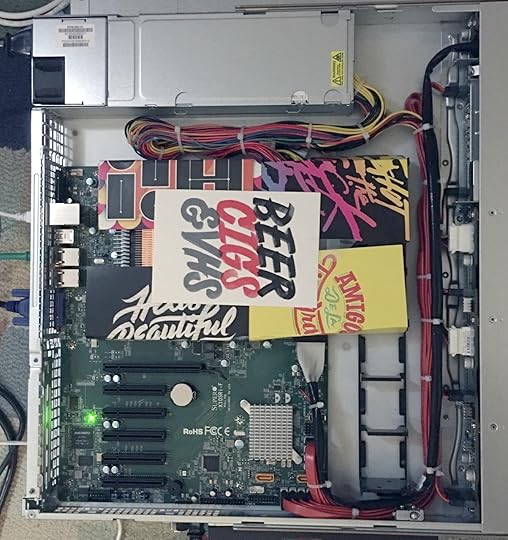
(I know, I know, it's a super janky duct! But I was prototyping!)
Sure enough, this duct, combined with the previous heatsink and TIM changes, enabled the server to remain stable overnight with a full MPrime run of 12 threads.

I think we've certainly demonstrated the surprising (to me, at least) value of fan shrouds. But before we get too excited, let's consider one last thing.
Define "CPU Load"
Sometimes you get so involved with solving the problem at hand that you forget to consider whether you are, in fact, solving the right problem.
In these tests, we defined 100% CPU load using MPrime. Some people claim MPrime is more of a power virus than a real load test, because it exerts so much heat pressure on the CPUs. I initially dismissed these claims since I've used MPrime (and its Windows cousin, Prime95) for almost 20 years to test CPU stability, and it's never let me down.
But I did more research and I found that MPrime, since 2011, uses AVX2 instructions extensively on newer Intel CPUs:
The newer versions of Prime load in a way that they are only safe to run at near stock settings. The server processors actually downclock when AVX2 is detected to retain their TDP rating. On the desktop we're free to play and the thing most people don't know is how much current these routines can generate. It can be lethal for a CPU to see that level of current for prolonged periods.
…
That's why most stress test programs alternate between different data pattern types. Depending on how effective the rotation is, and how well that pattern causes issues for the system timing margin, it will, or will not, catch potential for instability. So it's wise not to hang one's hat on a single test type.
This explains why I saw such a large discrepancy between other CPU load programs like BurnP6 and MPrime.
MPrime does an amazing job of generating the type of CPU load that causes maximum heat pressure. But unless your servers regularly chew through zillions of especially power-hungry AVX2 instructions this may be completely unrepresentative of any real world load your server would actually see.
Your Own Personal Inferno
Was this overkill? Probably. Even with the aluminum heatsink, no change to thermal interface material, and zero ducting, we'd probably see no throttling under normal use in our server rack. But I wanted to be sure. Completely sure.
Is this extreme? Putting 140 TDP of CPU heat in a 1U server? Not really. Nick at Stack Overflow told me they just put two 22 core, 145W TDP Xeon 2699v4 CPUs and four 300W TDP GPUs in a single Dell C4130 1U server. I'd sure hate to be in the room when those fans spin up. I'm also a little afraid to find out what happens if you run MPrime plus full GPU load on that box.
Servers are an admittedly rare example of big CPU performance heat and size tradeoffs, one of the few left. It is fun to play at the extremes, but the SoC inside your phone makes the same tradeoffs on a smaller scale. Tiny infernos in our pockets, each and every one.
[advertisement] At Stack Overflow, we put developers first. We already help you find answers to your tough coding questions; now let us help you find your next job.
November 22, 2016
Let's Encrypt Everything
I'll admit I was late to the HTTPS party.
But post Snowden, and particularly after the result of the last election here in the US, it's clear that everything on the web should be encrypted by default.
Why?
You have an unalienable right to privacy, both in the real world and online. And without HTTPS you have zero online privacy – from anyone else on your WiFi, from your network provider, from website operators, from large companies, from the government.
The performance penalty of HTTPS is gone, in fact, HTTPS arguably performs better than HTTP on modern devices.
Using HTTPS means nobody can tamper with the content in your web browser. This was a bit of an abstract concern five years ago, but these days, there are more and more instances of upstream providers actively mucking with the data that passes through their pipes. For example, if Comcast detects you have a copyright strike, they'll insert banners into your web content … all your web content! And that's what the good guy scenario looks like – or at least a corporation trying to follow the rules. Imagine what it looks like when someone, or some large company, decides the rules don't apply to them?
So, how do you as an end user "use" encryption on the web? Mostly, you lobby for the websites you use regularly to adopt it. And it's working. In the last year, the use of HTTPS by default on websites has doubled.
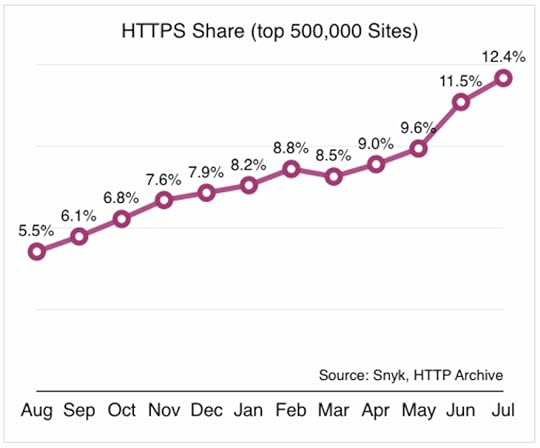
Browsers can help, too. By January 2017, Google Chrome will show this alert in the UI when a login or credit card form is displayed on an unencrypted connection:

Additionally, Google is throwing their considerable weight behind this effort by ranking non-encrypted websites lower in search results.
But there's another essential part required for encryption to work on any websites – the HTTPS certificate. Historically these certificates have been issued by certificate authorities, and they were at least $30 per year per website, sometimes hundreds of dollars per year. Without that required cash each year, without the SSL certificate that you must re-purchase every year in perpetuity – you can't encrypt anything.
That is, until Let's Encrypt arrived on the scene.
Let's Encrypt is a 501.3(c)(3) non-profit organization supported by the Linux Foundation. They've been in beta for about a year now, and to my knowledge they are the only reliable, official free source of SSL certificates that has ever existed.
However, because Let's Encrypt is a non-profit organization, not owned by any company that must make a profit from each SSL certificate they issue, they need our support:
As a company, we've donated a Discourse hosted support community, and a cash amount that represents how much we would have paid in a year to one of the existing for-profit certificate authorities to set up HTTPS for all the Discourse websites we host.
I urge you to do the same:
Estimate how much you would have paid for any free SSL certificates you obtained from Let's Encrypt, and please donate that amount to Let's Encrypt.
If you work for a large company, urge them to sponsor Let's Encrypt as a fundamental cornerstone of a safe web.
If you believe in an unalienable right to privacy on the Internet for every citizen in every nation, please support Let's Encrypt.
[advertisement] Find a better job the Stack Overflow way - what you need when you need it, no spam, and no scams.
Jeff Atwood's Blog
- Jeff Atwood's profile
- 34 followers


